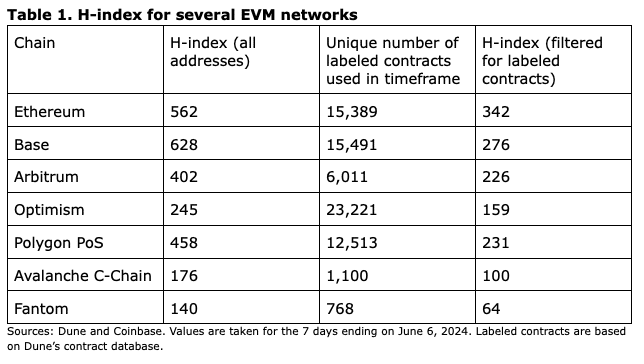Crypto exchange Coinbase has unveiled a new metric dubbed the h-index to address distortions in tracking onchain adoption caused by airdrop-related activities.
Coinbase, a publicly traded U.S.-based cryptocurrency exchange, known for its development of Base, a layer-2 solution for Ethereum, has introduced a new metric to provide a more accurate measure of blockchain network adoption. This new metric aims to mitigate distortions caused by airdrop-related activities and Sybil attacks.
In a research report on Friday, Coinbase noted that investments in blockchain infrastructure have led to an excess of blockspace, making onchain transactions cheaper and fueling networks with a new wave of decentralized applications. However, this change also made it challenging for analysts to track ecosystem adoption as more applications launch.
Traditional network metrics such as total transactions or daily active addresses can be skewed by Sybil attacks and airdrop activities, Coinbase says. To address this issue, Coinbase proposes a new metric called the h-index, which balances the depth and breadth of onchain adoption. The h-index counts the number of addresses receiving transactions from at least that same number of unique sending addresses.
“In other words, an h-index of 100 means that 100 different receiving addresses had received transactions from at least 100 unique sending addresses over a given time frame.”
Coinbase
According to Coinbase’s findings, when h-index applied, Ethereum and Base networks exhibited the most widespread user activity for the week ending Jun 6, followed by Arbitrum and Polygon.

While acknowledging the metric’s imperfections, Coinbase believes the h-index can shed “new perspectives on comparative chain adoption by mitigating the outsized influences of Sybils and measuring growth more broadly.”
The crypto exchange noted though that challenges still remain, including differences in blockchain execution environments, which can affect transaction formats and data interpretation. Additionally, the influence of exchange or other smart contract wallets “could also distort numbers,” Coinbase admits.
Sybil attacks are a well-known type of network attack in the crypto industry where a single entity creates multiple fake identities or nodes to gain control over a network or influence its operation. This sort of activity can manipulate network metrics and data by creating numerous false accounts or addresses to inflate transaction volumes or user activity artificially to distort the perception of network usage and adoption.
